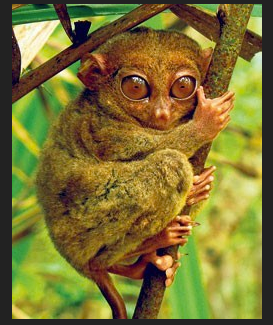The Pygmy Tarsier
The creature we’re going to discuss today looks like a
Mogwai, or Gremlin, but it’s not. The Chinese use the word Mogwai to describe
certain demons, which inflict harm on humans. If you saw the movie Gremlins,
then you’ll know what I’m talking about. And although there is some local fear of the Pygmy Tarsier, it is definitely not like a Mogwai. If you haven’t seen a Mogwai, here’s a
picture of one from the film. It’s quite possible that the Pygmy Tarsier was
the model for the Mogwai. I don’t know that for certain, but there are some strikingly
similar characteristics.
He’s kinda cute, until you get him wet, the Mogwai, that is, not the Pygmy Tarsier. I think the Pygmy Tarsier would be a bit upset if he knew about the Mogwai, but we don’t need to worry about that.
The Pygmy Tarsier is a very rare and specialized primate, and he is an ancient predecessor to humans.
For 85 years, the Pygmy Tarsier was thought to be extinct.
Then in 2008 a small group was found in Indonesia. They are endemic (restricted
to one place) to Central Sulawesi, Indonesia.
Found at elevations between 5900 and 7200 feet, Pygmy
Tarsiers are most comfortable in the lower canopy of trees, but will also walk
on the forest floor if need be. The trees at that elevation are not very tall, the leaves
are small, and the diversity of tree species is limited. There is high humidity
in these forests and a constant presence of mist. The Pygmy Tarsier is at home
here.
Pygmy
tarsiers are easily distinguished from other tarsiers by their small body size.
Their average weight is approximately 1½ pounds. This weight is less than half
the size of lowland tarsier species. There is some debate as to how many species of tarsier there are. Of all the species, the Pygmy Tarsier is the smallest. Although weight sometime distinguishes
males from females, Pygmy Tarsiers do not express sexual dimorphism. That means that the males and females don't differ in size.
The Pygmy Tarsier’s eyes are approximately the same
size as its brain. They are nocturnal animals, and their large eyes help them
to see well in the dark. This wide field of vision is accompanied by the
ability to rotate their head nearly 360 degrees. They are either watching for
enemies or their next meal to come along.
They have a long slender tail for balance, and long
bony ‘fingers’ for clinging to branches. These adaptations enable them to move swiftly through the lower canopy. They can leap several feet from tree to tree, and their ‘jumping’ tends
to be froglike.
Pygmy Tarsiers spend a lot of time scanning for insects on
lower positions of tree trunks, and although they do not build nests, they tend
to return to a particular tree to sleep. When awake, Pygmy Tarsiers will
continually furl or crinkle their ears. This is another way to remain alert for
bugs and enemies.
Only
one group of Pygmy Tarsiers has been observed in the wild. Aggressive logging
has resulted in the decrease in their numbers. However, at this point, the IUCN* does not have enough data to tell us how bad
the situation is. Suffice it to say, there is only a handful left in the wild.
I have embedded a video for you and the kids to enjoy. Kids,
look closely at the video. You’ll get a chance to see how the Pygmy Tarsiers
move and crinkle their ears, and how they eat an evening meal. Hope you visit
the web site to view it. While you’re there, don’t be shy, leave a comment.
*IUCN- International Union for Conservation of Nature and Natural Resources
If you would like to read more about the Pygmy Tarsier, here is a WEB site that has more detailed information;
Food for thought people: Experts believe that approximately, 27,000 species of wildlife disappear every year, and will never be seen again. It's important to learn and understand these animals. Our lives may depend on it.
Thanks from me for visiting, and from the Pygmy Tarsier for
thinking about him for a moment.
Enjoy!
J.E. Rogers







Loved it, Jeanne. They are so cute.
ReplyDeleteClancy
Some of the tarsiers shown here are not pygmy tarsiers but are Philippines Tarsier. Pygmy Tarsiers have small eyes compared to Philippines Tarsiers. Philippines Tarsiers are mostly seen in Bohol, Philippines and Pygmy is in Sulawesi, Indonesia. Please at least use the correct images when creating posts about specific species.Here's a picture of a Philippine Tarsier and a Pygmy Tarsier together:
ReplyDeletehttp://media-cache-ak0.pinimg.com/736x/5d/03/2e/5d032e3a21e1b9905b433112c857b8c9.jpg
As you can see PH tarsiers have bigger eyes compared to the Indonesian ones.